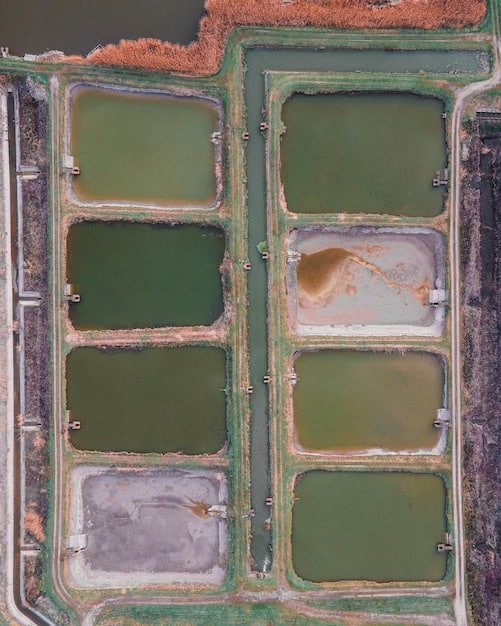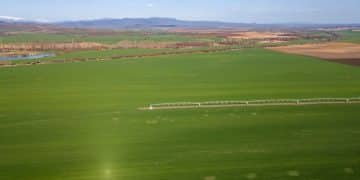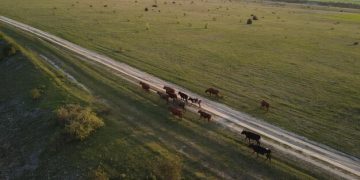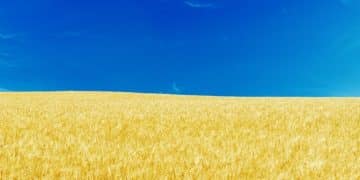Unlocking Profit: Water Conservation’s Financial Edge in Sustainable Agriculture

Exploring the financial benefits of water conservation techniques in sustainable agriculture reveals significant cost savings, increased yields, and long-term economic stability for farmers and the environment.
Discover how exploring the financial benefits of water conservation techniques in sustainable agriculture can transform farming practices, boosting profitability while safeguarding our planet’s most precious resource.
The Economic Case for Water Conservation in Agriculture
Water conservation is no longer just an environmental imperative; it’s becoming an economic necessity for farms across the United States. Implementing efficient water management strategies can significantly reduce operational costs and improve long-term financial viability.
Let’s delve into the specific ways that these techniques translate into tangible economic benefits for farmers and the wider agricultural sector.
Reducing Water Bills with Efficient Irrigation
One of the most direct financial incentives for water conservation is reduced expenditure on water bills. Traditional irrigation methods often lead to significant water wastage, driving up costs unnecessarily.
- Drip Irrigation: Delivers water directly to plant roots, minimizing evaporation and runoff, leading to significant water savings.
- Sprinkler Systems: Modern, efficient sprinkler systems use targeted water distribution to reduce water waste compared to older models.
- Soil Moisture Sensors: These devices monitor soil water content, enabling farmers to irrigate only when necessary, avoiding overwatering.
By reducing the volume of water used, farmers can drastically lower their utility bills, making their operations more profitable.

Investing in more efficient irrigation infrastructure creates a more sustainable and profitable business.
Boosting Crop Yields Through Water Management
Efficient water conservation techniques can also lead to improved crop yields. By ensuring crops receive the right amount of water at the right time, farmers can optimize plant growth and productivity.
This increased productivity translates directly into more revenue.
Optimizing Crop Water Use
Understanding and optimizing crop water usage is critical for maximizing yields while conserving water. Different crops have different water requirements, and providing the right amount can boost productivity.
- Matching Crops to Climate: Choosing crop varieties that are well-suited to the local climate and rainfall patterns reduces the need for irrigation.
- Precision Irrigation Techniques: Drip irrigation and micro-sprinklers deliver water directly to the roots, minimizing water loss and maximizing uptake.
- Scheduling Irrigation Based on Plant Needs: Using weather data and soil moisture sensors to schedule irrigation ensures that crops receive water only when they need it.
By taking care of crop needs yields will improve.
Optimizing crop water use not only increases yields but also improves the quality of the produce, leading to higher market prices.
Government Incentives and Rebates for Water Conservation
The US government offers a variety of financial incentives, rebates, and grants to encourage farmers to adopt water conservation practices. These programs can significantly reduce the upfront costs of implementing new technologies and management strategies.
Let’s examine some of these options.
Exploring Federal and State Programs
Numerous federal and state programs are available to support farmers investing in water conservation. These programs often provide financial assistance, technical support, or both.
- Environmental Quality Incentives Program (EQIP): Provides financial and technical assistance to implement conservation practices on agricultural lands.
- Conservation Stewardship Program (CSP): Rewards farmers who actively manage existing conservation practices and implement new ones.
- State-Specific Rebates: Many states offer rebates for specific water conservation technologies, such as drip irrigation systems or soil moisture sensors.
Leveraging these incentives can offset the initial investment costs and accelerate the adoption of water-saving technologies.

Financial assistance from the government can prove invaluable for those working toward efficient systems around their farm.
Long-Term Cost Savings Through Sustainable Practices
While the initial investment in water conservation technologies may seem significant, the long-term cost savings can be substantial. By reducing water consumption, energy usage, and fertilizer runoff, farmers can create more sustainable and profitable operations.
Let’s look into the different savings.
Reduced Energy and Fertilizer Costs
Water conservation practices often lead to reduced energy and fertilizer costs. Efficient irrigation systems require less energy to operate, and reduced water runoff minimizes fertilizer losses.
Many farmers who implement efficient systems and strategies are able to significantly lower their costs.
Minimizing Environmental Impact
Water conservation practices also minimize environmental impacts, such as nutrient pollution and soil erosion. The reduced need for fertilizers and pesticides can lead to healthier ecosystems and improved water quality.
Conserving water helps to protect the environment and maintain the long-term health and productivity of agricultural lands.
Risk Management and Resilience in the Face of Drought
In regions prone to drought, water conservation is essential for managing risk and ensuring the resilience of agricultural operations. By reducing their reliance on scarce water resources, farmers can better withstand periods of drought and water scarcity.
Drought is one of the biggest impediments facing farmers across the USA.
Adapting to Changing Climate Patterns
As climate change leads to more frequent and severe droughts, farmers must adapt their practices to ensure water security. Water conservation techniques can help farmers to build resilience and maintain productivity in the face of changing climate patterns.
Practices to consider are diverse cover crops and water retention, both of which prove highly effective.
Building a More Sustainable Future
Investing in water conservation is not just a smart business decision; it’s also a responsible choice for the environment. By reducing water consumption, minimizing pollution, and protecting ecosystems, farmers can contribute to a more sustainable future for all.
The benefits of working towards conservation far outweigh any short-term financial investments.
Case Studies: Successful Water Conservation Implementations
Real-world examples provide tangible support for the benefits of water conservation practices. These case studies can encourage other people to invest in efficient systems and strategies.
Let’s consider some of their outcomes from the past few years.
Examples From USA Farms
Successful implementations of water conservation techniques are already being showcased on farms across the US, with significant environmental and economic outcomes.
By implementing the best strategies and practices, positive results always follow without fail.
Incorporating practices that work towards soil health and water efficiency are becoming commonplace for farmers across the USA.
| Key Point | Brief Description |
|---|---|
| 💧 Efficient Irrigation | Reduces water waste and lowers water bills significantly. |
| 🌱 Boosted Crop Yields | Optimizes plant growth, leading to increased productivity. |
| 💸 Government Incentives | Reduces upfront costs through rebates and programs. |
| 🛡️ Drought Resilience | Ensures stability amidst water scarcity with conservation techniques. |
Frequently Asked Questions
▼
Sustainable agriculture focuses on farming practices that are environmentally sound, economically viable, and socially equitable, ensuring resources are available for future generations.
▼
It reduces water bills, increases crop yields through optimal irrigation, and lowers energy and fertilizer costs, contributing to higher profits.
▼
Drip irrigation delivers water directly to plant roots, while modern sprinkler systems and soil moisture sensors help avoid overwatering and optimize water use.
▼
Yes, the Environmental Quality Incentives Program (EQIP) and Conservation Stewardship Program (CSP) provide financial and technical assistance to farmers.
▼
It reduces reliance on scarce water resources, making farms more resilient to drought and enabling them to maintain productivity during water scarcity.
Conclusion
Exploring the financial benefits of water conservation techniques in sustainable agriculture reveals not only ecological responsibility but also significant economic opportunities. By adopting efficient irrigation, leveraging government incentives, and managing water sustainably, farmers across the US can enhance their profitability while contributing to a healthier planet, turning conservation into a win-win strategy for agriculture and the environment.





